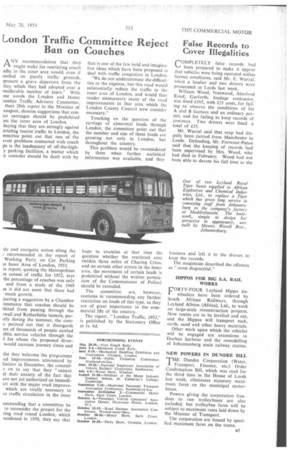,ondon Traffic Committee Reject Ban on Coaches
Page 39

If you've noticed an error in this article please click here to report it so we can fix it.
ANY recommendation that they might make for restricting coach &lc in the inner area would, even if stifled on purely traffic grounds, present a grave departure from the ilicy which they had adopted over a nsiderable number of 'years." With ese words the London and Home mnties Traffic Advisory Committee, their 28th report to the Minister of -ansport, dismiss suggestions that conlet carriages should be prohibited am the inner area of London.
Saying that they are strongly against itricting tourist traffic to London, the mmittee point out that one of the ivest problems connected with coach ps is the inadequacy of off-the-highy parking facilities, a matter which :y consider should be dealt with by :dy and energetic action along the ; reCommended in the report of Working Party on Car Parking le Inner Area of London, 1953.
se report, quoting the Metropolitan census of traffic for 1952, says the percentage of coaches was only and from a study of the 1949 as it did not seem that there had much growth.
:jecting a suggestion by a Chamber 'ommerce that coaches should be ibited from passing through the :wall and Rotherhithe tunnels, partrly during the summer, the come pointed out that it disregards ms of thousands of people carried ablic service vehicles through the 1 for whom the proposed diverwould increase journey times and dist they welcome the programme ad improvements announced by linister in December, the commita on to say that they "cannot al their anxiety of the fact that ave not yet authorized an immediirt with the major road improvewhich are vitally necessary to ye traffic circulation in the inner ommending that a committee be to reconsider the project for the ring road round London, which )andoned in 1950, they say that that is one of the few bold and imaginative ideas which have been proposed to deal with traffic congestion in London.
"We do not underestimate the difficulties or the expense, but this road would substantially reduce the traffic in the inner area of London, and would thus render unnecessary many of the road improvements in that area which the London County Council now consider necessary."
Touching on the question of the carriage of abnormal loads through London, the committee point out that the number and size of these loads arc growing not only in London, but throughout the country.
This problem would be reconsidered by them when further statistical information was available, and they
hope to examine at that time the question whether the restricted area (within three miles of Charing Cross, and on certain other streets in the inner area, the movement of certain loads is prohibited without the written permission of the Commissioner of Police) should be extended.
The committee are, however, cautious in recommending any further restriction on loads of this type, as they are of great importance to the commercial life of the country.
The report, "London Traffic, 1953," is published by the Stationery Office at Is. 6d.




































































































